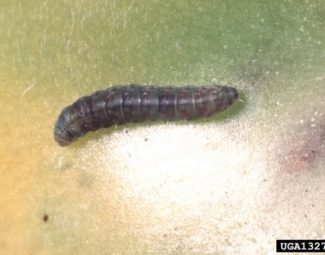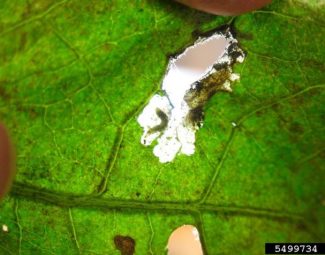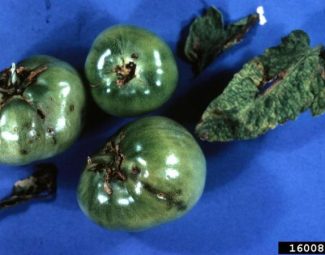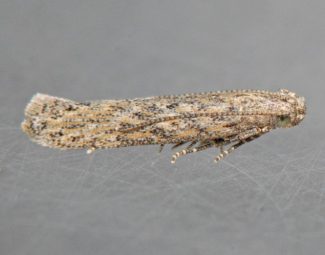Tomato Pinworm
Insect Summary Report
Keiferia lycopersicella
General Information
- Tomato Pinworm host plants include tomato, eggplant, and potato.
- Weed hosts include nightshade and horsenettle.
- Damage can be confused with that of leafminers and potato tuberworms.
- Larval stages feed on vegetative, as well as fruiting structures. Initial damage will appear as blotchy leaf mines. Older instar damage includes leaves that are folded and/or tied together by secreted threads and damage to fruit by direct internal, shallow feeding.
- Feeding damage can make hosts vulnerable to secondary infections by various opportunistic plant pathogens.
- Broad-spectrum insecticide use can reduce natural controls and increase survival rates of Tomato Pinworm.
- Later instars are much more difficult to control than early instar larva.
- They use sex pheromone for mating recognition.
Life Cycle (26-100 Days)
- Eggs… (4-8 Days) Oval in shape and very small. Laid singly or in small groups of 2 or 3 underneath leaves. White or yellow-white and turn orange before hatch.
- Larva… (10-28 Days) 4 instars. After hatch, spins web around itself and forms a mine underneath the surface of the leaf as it feeds. White in color with brown or black head. Later instars use webbing to tie or fold leaves and feed within the protection of the leaves. Prefer to feed on fruiting structures when available. When fruit is fed upon, the calyx is most common entry point. Entry hole is small and not easily seen with unaided eye. Brown frass (excrement) may be seen around the area of the calyx. Later instars are gray or yellow in color with reddish-purple rings. Lowers itself to ground to pupate by producing thread, but may occasionally pupate in leaves or fruiting structures.
- Pupa… (15-30 Days) Larva forms pupa underneath surface of soil with loose aggregation of soil and webbing. Brown in color.
- Adult…(7-23 Days) Mate 24-48 hours after emergence. Nocturnal, grey with black specks.
Over-wintering Strategy
Over-winter near surface of the soil as pupa, but are very susceptible to cold temperatures. Usually only survive winter months in southern states. Emerge March-May.
Sampling
Pheromone baited delta sticky traps placed at canopy height are commonly used to detect the presence of adult moths. Leaves of crop plants should be randomly sampled for signs of egg deposition and/or larval feeding. Fruiting structures should be visually inspected for feeding damage.
Organic Control
- General Info
- Several native wasp and fly parasites serve as natural control in most conditions. Trichogramma wasps have been identified as being parasites of the eggs and are commercially available for augmentative release. Various fungal and bacterial pathogens also serve as important natural controls.
- Naturally occurring predators of eggs and larva include: minute pirate bugs, lacewings, big-eye bugs, damsel bugs and various spiders.
- Synthetic, high-rate pheromone dispensers can be used for mating disruption.
- Electric light traps can be useful. Adults are drawn to the light.
- Commonly Used Control Products
- Ferti-Neem Oil
- Ferti-Organics Karanja Oil
- Biorepel (Garlic Oil)
- Bt: Agree; Xentari; Dipel; Javelin
- Neemix 4.5 (Botanical)
- Entrust (Spinosad)
Cultural Control
- Maintain good fertility and mineral balance in plants. Identify macro- and micronutrient deficiencies by performing plant tissue and soil analysis. Adjust for deficiencies with foliar and soil applied applications of appropriate fertilizers.
- If transplants are used, inspect them before purchase for signs of feeding and egg deposition.
- Destroy vegetative materials and crop residue immediately after harvest by disking or burning.
- Control or mow weeds that serve as hosts.
- Early spring planting and/or early maturing varieties can encourage early harvest before populations build to economic thresholds.
- When possible, schedule 2-3 months or more when host crops are not available. This is most effective during winter months when environmental conditions are most severe for pest survival.
Bibliography
- Image by Natasha Wright, Cook’s Pest Control, Bugwood.org (adult tomato pinworm)
- Image by Mark Dreiling, Bugwood.org (adult tomato pinworm with wings closed)
- Image by James Hayden, FDACS Division of Plant Industry, Bugwood.org (tomato pinworm)
- Images by Alton N. Sparks, Jr., University of Georgia, Bugwood.org (pinworm larva and tomato pinworm larva on tomato fruit damage)
- Image by James Hayden, Microlepidoptera on Solanaceae, USDA APHIS PPQ, Bugwood.org (leaf damage on eggplant)
- Image by John C. French Sr., Retired, Universities:Auburn, GA, Clemson and U of MO, Bugwood.org (damage to tomatoes)
- http://www.ces.ncsu.edu/depts/ent/notes/Vegetables/veg33.html (Confusion with other species, pheromone control, conventional control)
- http://www.omafra.gov.on.ca/english/crops/facts/04-025.htm (Host crops, life cycle, Trichogramma)
- http://ipm.ncsu.edu/ag295/html/tomato_pinworm.htm (Overwintering, host weeds)






